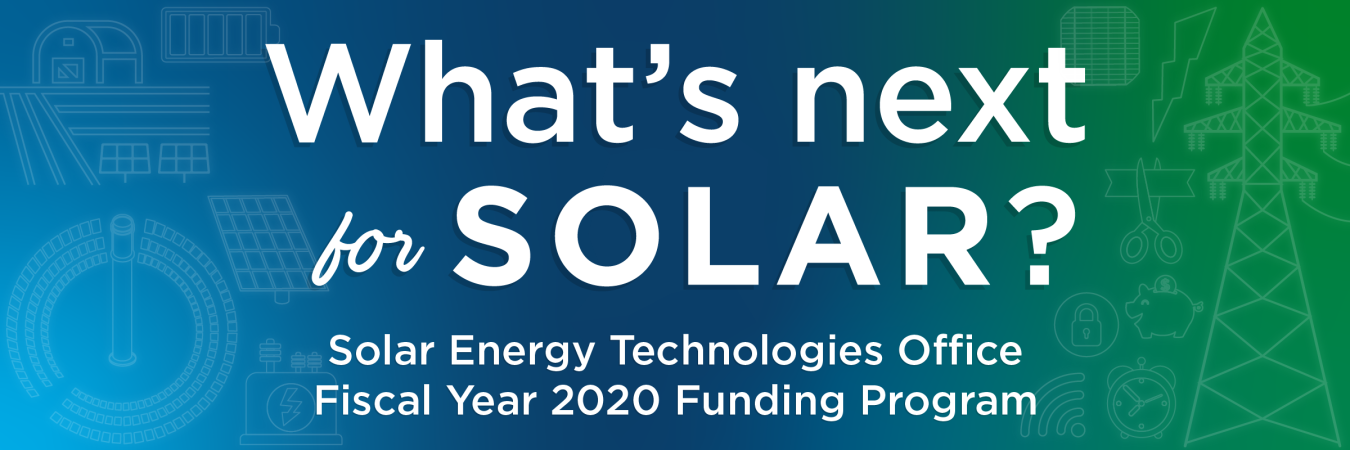
The Solar Energy Technologies Office Fiscal Year 2020 funding program (SETO 2020) funds research projects that advance early-stage solar technologies to reduce the cost of solar, increase U.S. competitiveness in manufacturing, improve grid reliability, and tackle emerging challenges in the solar industry.
On February 5, 2020, the U.S. Department of Energy announced $130 million in funding for 55-80 projects.
On November 18, 2021, an additional selection was made for the SETO 2020 funding program with an additional $750,000 in funding.
Approach
This funding program seeks to advance technologies that will help SETO reach its 2030 cost targets while enabling utilities to manage a grid with more solar energy.
The SETO 2020 funding program contains multiple topic areas. A list of individual projects can be found on the following topic webpages:
- Photovoltaics (PV) Hardware Research
These projects will improve the functions of PV hardware over the long term, maximizing energy yields, increasing efficiency, and improving PV system modeling to ensure reliable performance prediction. - Integrated Thermal Energy Storage and Brayton Cycle Equipment Demonstration (Integrated TESTBED)
This project team will develop, build, and operate a supercritical carbon dioxide (sCO2) power cycle integrated with thermal energy storage at 550°C to 630°C temperatures. The goals are to accelerate the commercialization of the sCO2 Brayton cycle and provide operational experience for utilities, operators, and concentrating solar-thermal power (CSP) developers. - Solar Energy Evolution and Diffusion Studies 3 (SEEDS 3)
These projects will work to understand the large-scale dynamics of the flow of solar information by studying how knowledge spreads throughout the solar energy ecosystem and how solar adoption interacts with other emerging energy technologies, such as energy storage. The goal is to reduce the non-hardware costs of solar energy by efficiently delivering knowledge to key stakeholders so decisions can be made quickly and effectively. - Innovations in Manufacturing – Hardware Incubator
These product ideas will lower the costs of solar energy technologies, facilitate the secure integration of solar electricity onto the grid, and support a strong U.S. solar manufacturing sector and supply chain. The goal is to bring prototypes to a pre-commercial stage and retire any business or market risks to spur follow-on private investments, patents, scientific and technical publications, and jobs. - Systems Integration
These projects will enhance solar energy’s ability to provide greater grid resilience and reliability to the grid, especially at the community level. This work will improve the ability of communities to maintain power during and restore power after man-made or natural disasters, improve cybersecurity for PV inverters and power systems, and develop advanced hybrid plants that operate collaboratively with other resources. - Solar and Agriculture: System Design, Value Frameworks, and Impacts Analysis
These projects will develop technologies, evaluate practices, and conduct research and analysis that enable farmers, ranchers, and other agricultural enterprises to gain value from solar technologies while keeping land available for agricultural purposes. The goal is to facilitate and expand the co-location of solar and agricultural activities where it benefits the local community as well as industries. - Artificial Intelligence (AI) Applications in Solar Energy with Emphasis on Machine Learning
These projects will leverage U.S. AI-related know-how to develop disruptive solutions across the solar industry value chain, forming partnerships between experts in AI and industry stakeholders. Stakeholders may include solar power plant operators or owners, electric utilities, PV module manufacturers, and others that can supply the necessary data and solar subject matter expertise. - Small Innovative Projects in Solar (SIPS): PV and CSP
These are innovative, novel, high-risk PV and CSP projects that can produce significant results within the first year of performance and potentially open up new avenues for continued study.
Objectives
Projects in this funding program will result in disruptive solutions that improve solar technology efficiency, lower electricity costs, improve management of solar on the grid, enhance the flow of information to solar stakeholders, and enable the pairing of solar with agriculture.
